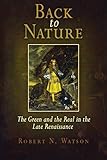Back to Nature : The Green and the Real in the Late Renaissance / Robert Watson.
Material type: TextPublisher: Philadelphia : University of Pennsylvania Press, [2013]Copyright date: ©2006Description: 1 online resource (448 p.) : 51 illusContent type:
TextPublisher: Philadelphia : University of Pennsylvania Press, [2013]Copyright date: ©2006Description: 1 online resource (448 p.) : 51 illusContent type: - 9780812220223
- 9780812204254
- English literature -- Early modern, 1500-1700 -- History and criticism
- Human ecology in literature
- Nature in literature
- Pastoral literature, English -- History and criticism
- Philosophy of nature in literature
- Renaissance -- England
- Literature
- LITERARY CRITICISM / European / English, Irish, Scottish, Welsh
- Cultural Studies
- Literature
- Medieval and Renaissance Studies
- 820.93609031
- online - DeGruyter
- Issued also in print.
| Item type | Current library | Call number | URL | Status | Notes | Barcode | |
|---|---|---|---|---|---|---|---|
 eBook
eBook
|
Biblioteca "Angelicum" Pont. Univ. S.Tommaso d'Aquino Nuvola online | online - DeGruyter (Browse shelf(Opens below)) | Online access | Not for loan (Accesso limitato) | Accesso per gli utenti autorizzati / Access for authorized users | (dgr)9780812204254 |
Browsing Biblioteca "Angelicum" Pont. Univ. S.Tommaso d'Aquino shelves, Shelving location: Nuvola online Close shelf browser (Hides shelf browser)

|

|

|

|

|

|

|
||
| online - DeGruyter Hastening Toward Prague : Power and Society in the Medieval Czech Lands / | online - DeGruyter Independence Hall in American Memory / | online - DeGruyter Inexpressible Privacy : The Interior Life of Antebellum American Literature / | online - DeGruyter Back to Nature : The Green and the Real in the Late Renaissance / | online - DeGruyter Creating Africa in America : Translocal Identity in an Emerging World City / | online - DeGruyter Imaginary Betrayals : Subjectivity and the Discourses of Treason in Early Modern England / | online - DeGruyter Rum Punch and Revolution : Taverngoing and Public Life in Eighteenth-Century Philadelphia / |
Frontmatter -- Contents -- Part I. Introduction The Green and the Real -- 1. Ecology, Epistemology, and Empiricism -- 2. Theology, Semiotics, and Literature -- Part II. Paradoxes Alienation from Nature in English Literature -- 3. As You Liken It: Simile in the Forest -- 4. Shades of Green: Marvell's Garden and the Mowers -- Part III. Reformations Protestant Politics, Poetics, and Paintings -- 5. Metaphysical and Cavalier Styles of Consciousness -- 6. The Retreat of God, the Passions of Nature, and the Objects of Dutch Painting -- 7. Nature in Two Dimensions: Perspective and Presence in Ryckaert, Vermeer, and Others -- Part IV. Solutions The Consolations of Mediation -- 8. Metal and Flesh in The Merchant of Venice: Shining Substitutes and Approximate Values -- 9. Thomas Traherne: The World as Present -- Conclusion -- Notes -- Bibliography -- Index -- Acknowledgments
restricted access online access with authorization star
http://purl.org/coar/access_right/c_16ec
Selected by Choice magazine as an Outstanding Academic TitleSweeping across scholarly disciplines, Back to Nature shows that, from the moment of their conception, modern ecological and epistemological anxieties were conjoined twins. Urbanization, capitalism, Protestantism, colonialism, revived Skepticism, empirical science, and optical technologies conspired to alienate people from both the earth and reality itself in the seventeenth century. Literary and visual arts explored the resulting cultural wounds, expressing the pain and proposing some ingenious cures. The stakes, Robert N. Watson demonstrates, were huge.Shakespeare's comedies, Marvell's pastoral lyrics, Traherne's visionary Centuries, and Dutch painting all illuminate a fierce submerged debate about what love of nature has to do with perception of reality.
Issued also in print.
Mode of access: Internet via World Wide Web.
In English.
Description based on online resource; title from PDF title page (publisher's Web site, viewed 24. Apr 2022)


